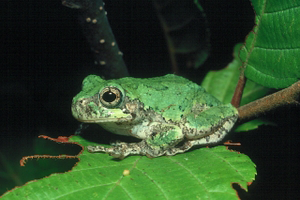Dryophytes versicolor is a tetraploid species that are thought to have originated multiple times through interbreeding of extant diploid gray tree frogs and two other, apparently extinct, lineages of tree frogs. Tetraploid lineages apparently then merged through interbreeding to form a single species.
Photo Credit: Geoffrey A. Hammerson
Dryophytes versicolor
Common Name: gray treefrog
Other Scientific Names: Hyla versicolor
Animal Guild: Amphibian
Class > Order > Family: Amphibia > Anura > Hylidae
What does the species look like?
This species is essentially identical to Cope's gray treefrog (Dryophytes chrysoscelis). The upper side has numerous small warts and is usually green (especially juveniles) to gray and often has a pattern that resembles lichens that grow on tree trunks. There is a light spot under each eye. The groin and concealed bases of the hind legs are orange-yellow with black mottling. Maximum size is about 2.5 inches (6 cm) snout-vent length. Breeding male can be recognized by its dark, loose, throat skin. Breeding calls are loud slow trills (often mistaken for a woodpecker's call), with pulses slower than in Cope's gray treefrog (Dryophytes chrysoscelis). Larvae have strongly arched tail fins that may be heavily mottled with black and often tinged red or orange# and (if not broken) ending in a slender filament. Larvae reach a total length of up to around 1.5 inches (3.8 cm). Egg masses contain clusters of about 6-45 eggs, floating free or loosely attached to submerged vegetation.
Where is the species found?
States & Provinces
AR, CT, DC, DE, GA, IA, IL, IN, KS, KY, LA, MA, MB, MD, ME, MI, MN, MO, MS, NB, NC, ND, NH, NJ, NY, OH, OK, ON, PA, QC, RI, SC, SD, TN, TX, VA, VT, WI, WV
Distribution
Range includes southeastern Canada from southern Manitoba to New Brunswick, and southward through the northeastern and south-central United States to North Carolina, West Virginia, Ohio, Indiana, Kentucky, Illinois, Tennessee, eastern Texas, and southwestern Louisiana, and west to North Dakota, Minnesota, Iowa, eastern Kansas and eastern Oklahoma.
Gray treefrogs inhabit various kinds of wooded and forested habitats and may occur on the ground or more often in shrubs or trees. Breeding sites include shallow woodland ponds and marshes, puddles, ponds in forest clearings, swamps, bogs, and many other kinds of permanent or temporary, natural or human-created waters lacking a significant current.
General Phenology and Life History
Most activity occurs at dusk and at night, especially in wet weather. Seasonally gray treefrogs migrate up to several hundred meters between nonbreeding terrestrial habitats and breeding pools. Breeding occurs in spring or summer, beginning as early as March in the southern part of the range and usually in May in the north. Females deposit clutches of up to about 2,000 eggs, distributed among several small clusters. Aquatic larvae hatch in a few days and metamorphose within 2 months. Away from breeding sites, gray treefrogs often call from and spend much time high up in trees. These frogs are inactive during the colder months of fall through early spring. When not active they hide in tree holes, under bark, in rotten logs, under leaves, and under tree roots.
Which phenophases should I observe?
Do you see/hear...?
Activity
Adults on land More...
For abundance, enter the number of individual animals observed in this phenophase.
Adults in water More...
For abundance, enter the number of individual animals observed in this phenophase.
Adults feeding For abundance, enter the number of individual animals observed in this phenophase.
Reproduction
Vocalizing What is the intensity of vocalizing?
Single calls: There is space between calls and individuals can be counted. Overlapping calls: Calls of individuals can be distinguished but there is some overlapping of calls. Full chorus: Calls are constant and overlapping.
Mating For abundance, enter the number of individual animals observed in this phenophase.
Fresh eggs For abundance, enter the number of individual animals observed in this phenophase.
Development
Dead adults For abundance, enter the number of individual animals observed in this phenophase.
What do these phenophases look like?
There is currently no photoguide available for this species. If you'd like help us create one, use the guidance document and species template provided here . Then send it via email to education@usanpn.org when it is complete.
